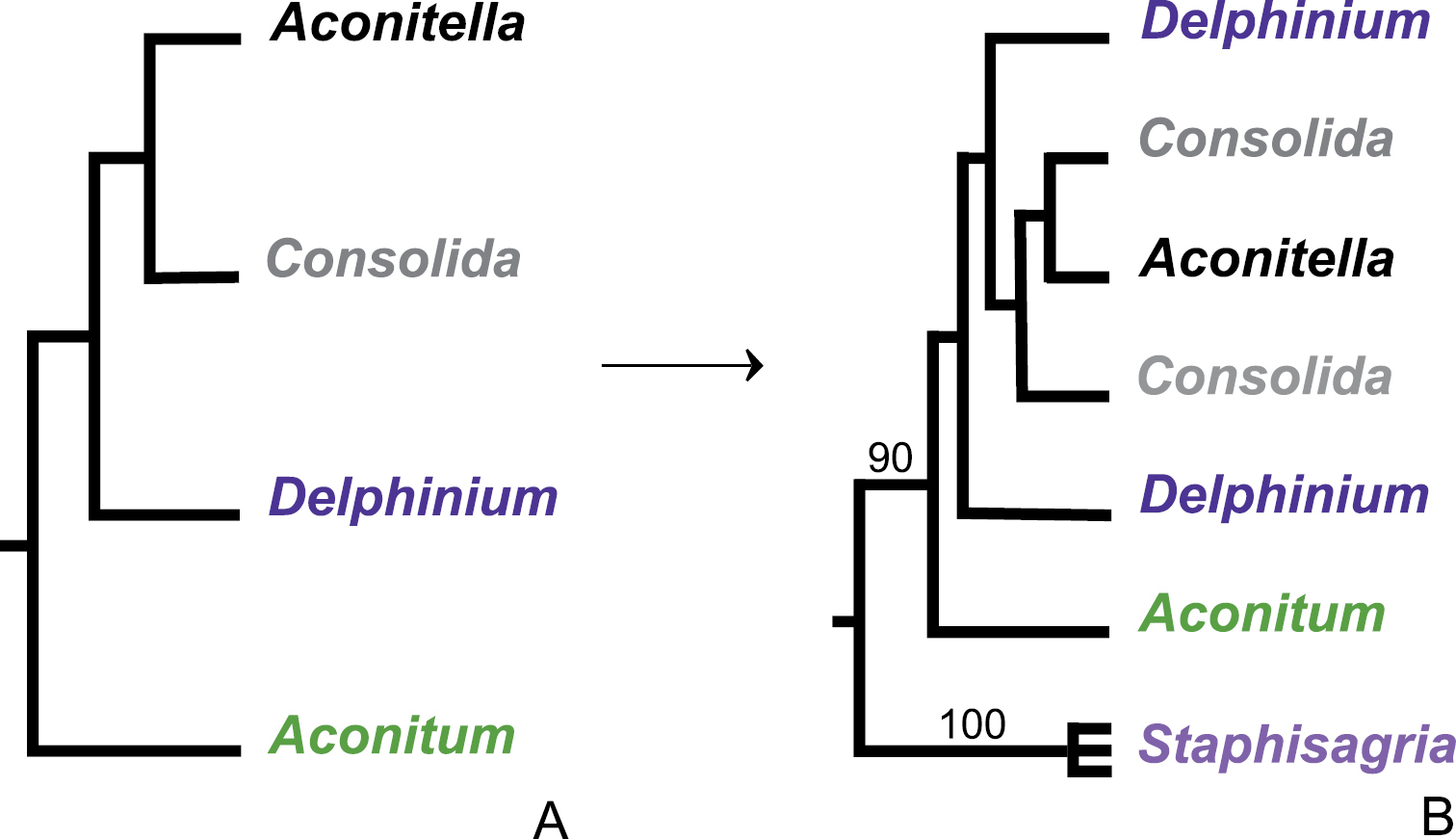






(C) 2011 Florian Jabbour. This is an open access article distributed under the terms of the Creative Commons Attribution License, which permits unrestricted use, distribution, and reproduction in any medium, provided the original author and source are credited.
For reference, use of the paginated PDF or printed version of this article is recommended.
Molecular sequence data show that the three species oDelphinium subg. Staphisagria (J. Hill) Peterm. form the sister clade to Aconitum L., Aconitella SpachConsolida (DC.) S.F. Gray, and all remaining species of Delphinium L. To account for this finding we resurrect Staphisagria J. Hill (1756). Names in Staphisagria are available for two of the species. We here make the required new combination for the third species, Staphisagria picta (Willd.) F. Jabbour, provide a key to the species, and illustrate one of them.
Aconitum, Delphinium, Mediterranean region, molecular phylogeny, nomenclature, Staphisagria
Delphinium staphisagria L., Delphinium requienii DC., and Delphinium pictum Willd. are annual or biennial species of the tribe Delphinieae (Ranunculaceae) that occur in the Mediterranean basin (see ‘Nomenclature and key to the species’ section for a more detailed description of their distribution areas). They are considered endangered (
Linnaeus knew only Delphinium staphisagria, which he described as Delphinium nectariis diphyllis, foliis palmatis lobis integris. With the recognition in the early 19th century that there were two additional species resembling Delphinium staphisagria,
Molecular phylogenetic studies of the Delphinieae recently revealed that the three species of Staphisagria sensu Spach are the sister clade to all other Delphinieae (Maximum Likelihood bootstrap support: 90%), a group of 650-700 species ranging from Eurasia into North America and with a few isolated species on West and East African mountains (Jabbour and Renner, unpublished data; Fig. 1). This discovery fits with several characters of the three species that are unusual in Delphinium. For example, Staphisagria species have eight chromosome pairs of staggered size (see Fig. 3 in
To account for the phylogenetic relationships in the Delphinieae (Fig. 1), we here resurrect the genus Staphisagria and make the required new combination for a species for which
Schematic representation of the phylogenetic relationships in the Delphinieae A as suggested by studies anterior to the findings of Jabbour and Renner (unpublished data) and B as found with combined nuclear (ITS) and plastid (trnL intron and adjacentrnL-trnF intergenic spacer) DNA sequences (2088 aligned nucleotides) from 191 accessions representing 185 species of Delphinieae (Jabbour and Renner, unpublished data). In this study, taxon sampling covered all genera and subgenera of the tribe. Numbers above branches indicate Maximum Likelihood bootstrap supports.
Delphinium staphisagria L., Sp. Pl.: 531. 1753 [original type, cited by its nomen specificum legitimum].
| 1 | Spur of the upper tepal 1/5-1/3 as long as perianth segments (Fig. 2C); seeds 5.5-7.5 mm (Fig. 2F) | Staphisagria macrosperma |
| – | Spur of the upper tepal at least 2/5 as long as perianth segments; seeds 3–4.5 mm | 2 |
| 2 | Inflorescence axis, pedicels, and outside of perianth segments shortly pubescent; bracteoles inserted at the base of the pedicels | Staphisagria picta |
| 2 | Inflorescence axis, pedicels, and outside of perianth segments villose-hirsute; bracteoles inserted at some distance above the base of the pedicels | Staphisagria requienii |
Delphinium staphisagria L., Sp. Pl.: 531. 1753. TYPE: LINN 694/12, Habitat in Istria, Dalmatia, Calabria, Apulia, Creta, Galloprovincia [South France]. The geographic origin of Linneaus’s type cannot be narrowed down (
Greece: Crete, Nomos Lassithiou, ravine between Zákros and Kato Zákros, 70 m, 15 May 2002, E. Vitek 02-205 (W, GZU, M, MA).
Spach had to chose a new name for this Linnaean species because Staphisagria staphisagria would be an exact tautonym (not permitted in botanical nomenclature), and since his misspelling of Hill’s genus (as Staphysagria) is a correctable error (variant spelling), Spach’s name Staphisagria macrosperma is legitimate. Among the three species of the genus Staphisagria, Staphisagria macrospermahas the largest distribution. Because of its ancient use in medicine (
Delphinium requienii DC., Fl. Franç. (DC. & Lamarck), ed. 3. 5: 642. 1805.
France: Var, Hyères, Porquerolles island, 12 Jun 1961, Gavelle s.n. (M).
Staphisagria requienii is a narrow endemic of the Mediterranean Archipelago of Hyères, Var, South of France (
Delphinium pictum Willd., Enum. Pl. [Willdenow] 1: 574. 1809. SYNTYPES: Röpert, D. (Ed.) 2000- (continuously updated): Digital specimen images at the Herbarium Berolinense. Published on the Internet http://ww2.bgbm.org/herbarium/ Barcode: B -W 10324 -01 0 / ImageId: 164585) and Barcode: B -W 10324 -02 0 / ImageId: 164601) [accessed 02-Sept-11].
Balearic Islands: Majorca, Puntas de Covas, top of sea cliffs, amongst limestone boulders, 100 m, April 1988, F.J. Rumsey s.n. (M).
The new combination is necessary because Staphisagria brevipes
Staphisagria macrosperma A young plant with the cotyledons and two palmate leaves B young inflorescence with floral buds subtended by a bract and bracteoles C side view of a flower showing the very short spur (or bulge) on the dorsal petaloid tepal D three-quarter view of a flower showing four developed staminodes: two lateral (black arrows) and two spurred (white arrows). The tips of the spurs are nested within the bulge of the dorsal tepal E three follicles F Gravity-dispersed poisonous seeds (c. 6 mm in length). Scale bars: 1 cm.
We thank Werner Greuter for nomenclatural advice and the anonymous reviewer who made important comments and suggestions. Financial support for FJ’s project came from the German Science Foundation (DFG) grant no. RE 603/12-1.

